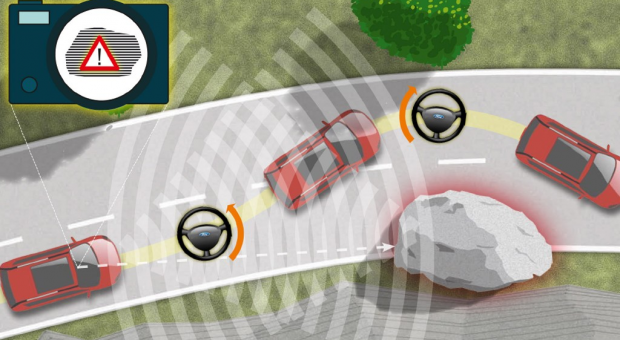
Ford test car that automatically steers near stopped or slowing vehicles makes NAIAS debut
Ford Motor Company today demonstrated a test car equipped with its obstacle avoidance technology that automatically steers and brakes to direct the vehicle away from traffic if the driver fails to steer or brake following system warnings.
This prototype technology represents another milestone in Ford’s Blueprint for Mobility, which envisions a future of automated functionality and advanced technologies to help improve safety, reduce congestion and achieve major environmental improvements. The sensor-based technologies found in driver-assist and semi-automated features like obstacle avoidance and fully assisted parking aid form the building blocks for the future of automated driving.
Featured on the Ford Edge Concept that debuted last month at the Los Angeles Auto Show, Ford’s obstacle avoidance uses automatic steering and braking to avoid collisions with vehicles that are stopped or slowing in the same lane ahead. The system issues warnings first if it detects slow-moving objects or stationary obstacles ahead. If the driver fails to steer or brake following those warnings, the system will then automatically steer and brake to avoid a collision. Obstacle avoidance builds on the foundation of several driver-assist technologies now being offered in many Ford products around the world.
The test car is a result of the findings of a four-year research project called interactIVe (Accident Avoidance by Active Intervention of Intelligent Vehicles), a Ford-led consortium consisting of 29 partners.
The obstacle avoidance demonstration was conducted for the first time in North America at the Dearborn Development Center test track in Michigan. Developed at Ford’s research facility in Aachen, Germany, obstacle avoidance is demonstrated on a Ford Focus, and serves as further proof of the proactive measures Ford has taken to research and develop accident-avoidance technologies.
Obstacle avoidance uses three radars, ultrasonic sensors and a camera to scan the road as far as 656 feet ahead. If the system detects a slow-moving or stationary object, it first displays a warning, then sounds a chime. If the driver does not steer or brake, the obstacle avoidance technology applies the brakes, scans for gaps on either side of the hazard, and takes control of the electronic power steering to avoid a collision. The technology has been tested at speeds greater than 38 mph.
Source, please read more.
















